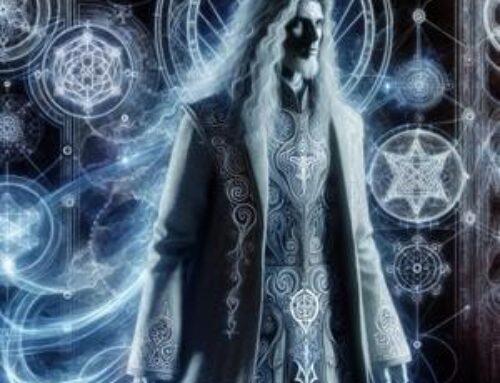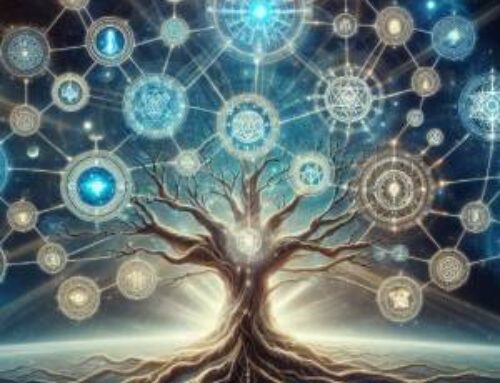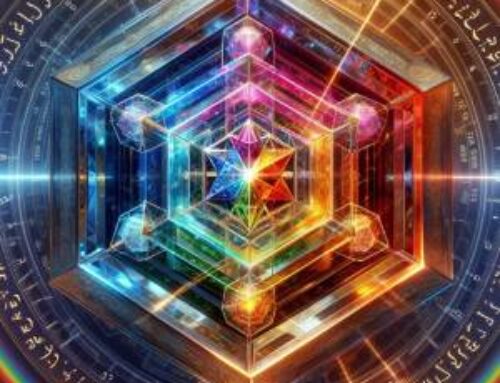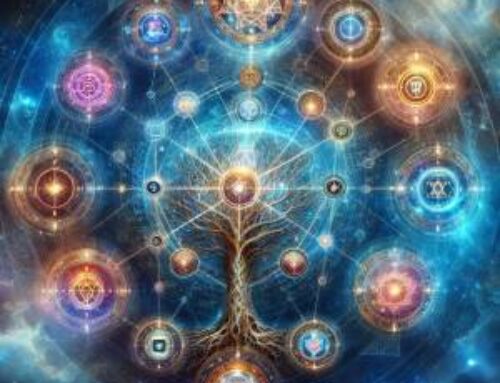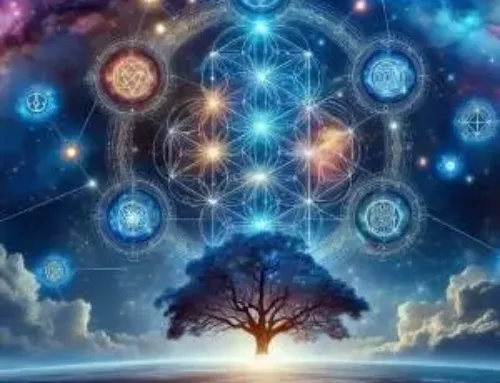Contents
- 1 Introduction to The Abyss Kabbalah
- 2 Understanding The Abyss: Definitions and Historical Context
- 2.1 Historical Context and Evolution
- 2.2 Practical Implications in Mystic Practices
- 2.3 Symbolic Representations of the Abyss in the Tree of Life
- 2.4 The Role of Da’at
- 2.5 Symbolism and Metaphysical Implications
- 2.6 Crossing the Abyss
- 2.7 Navigating the Abyss: Challenges and Transformations
- 2.8 Confronting the Abyss
- 2.9 Transformation Through the Abyss
- 3 Conclusion
- 4 FAQ – The Abyss Kabbalah
- 5 References:
Introduction to The Abyss Kabbalah
In the shadowy contours of mystical tradition, the concept of “the abyss kabbalah” stands as a formidable chasm within the spiritual landscape, challenging the intrepid souls who dare to navigate its depths. This esoteric abyss is not merely a void but a pivotal threshold within the Kabbalistic Tree of Life, marked by ‘Da’at’ (Hebrew: DOTh), a hidden sephira that lies between the Supernal Triad and the lower, more manifest sephirot. Here, the spiritual aspirant encounters the profound paradox of ‘Knowledge’—the abyss is both nothing and everything, an emptiness brimming with the potential for profound understanding.
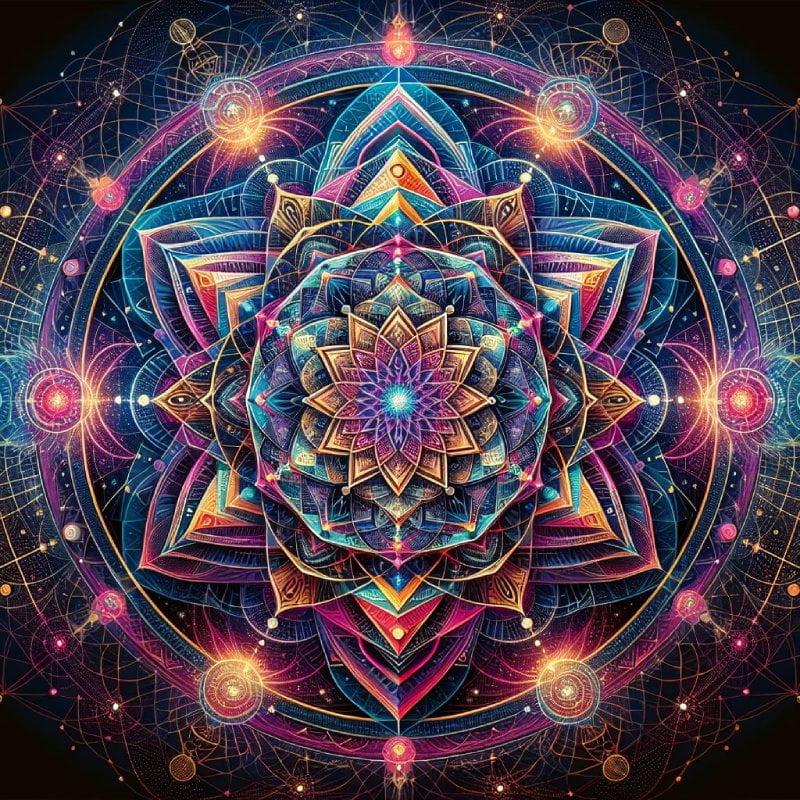
For scholars and practitioners of the Kabbalah, the abyss represents the ultimate test of spiritual fortitude, a place where one’s accumulated insights from the earthly plane are challenged by the incomprehensible vastness of the divine. It is here that the soul undergoes a rebirth, shedding its former limitations to emerge renewed, with a wisdom that is celestial in its scope and purity. This transformative journey through the abyss is emblematic of the Hermetic maxim “as above, so below”, where the microcosm reflects the macrocosm, and personal evolution mirrors cosmic unfoldment.
God is the all-working; He is the effect of Nature, working for the perfecting of the Universe.” (Book II: To Asclepius) – Suggesting the alchemical work as part of the divine plan for perfection (1).
Understanding The Abyss: Definitions and Historical Context
The term “the abyss kabbalah” is central to understanding the mystical architecture of the Kabbalah, specifically within the Tree of Life. Traditionally, the abyss represents a significant divide between the Supernal Triad of Kether, Chokmah, and Binah—the most ethereal aspects of the divine manifestation—and the lower, more accessible sephirot. This void symbolizes a spiritual challenge, an expanse that aspirants must cross to transition from theoretical knowledge to practical wisdom.
The Tree of Life is intricately connected with the Sephiroth, each representing different attributes of God and forming the backbone of Kabbalistic cosmology (2).
Historical Context and Evolution
Historically, the concept of the abyss in Kabbalistic study is not merely an obstacle but a necessary passage for profound spiritual transformation. It has been described in various texts as a daunting zone of spiritual trial, where the metaphysical aspects of the soul are tested to their limits. The abyss is a barrier and a bridge—a place where the soul confronts the ultimate boundaries of spiritual understanding and the illusions of the material world.
In the lore of the Kabbalah, crossing the abyss is akin to undergoing a second spiritual birth. The mystic journey through the abyss involves confronting and overcoming inner darkness, represented by the void. This is often depicted as a necessary dissolution of the ego, where the soul is stripped of all pretense and laid bare in its quest for divine truth.
Practical Implications in Mystic Practices
In practical Kabbalistic practices, the abyss is both revered and feared. It is revered as a stage of deep spiritual significance, feared for the spiritual peril it represents. Initiates are taught that to approach the abyss without adequate preparation is to invite spiritual disintegration rather than enlightenment. Proper guidance and readiness are emphasized as essential to navigating this profound gap.
Symbolic Representations of the Abyss in the Tree of Life
In Kabbalistic tradition, “the abyss kabbalah” occupies a pivotal place within the Tree of Life, acting as a profound divide that aspirants must cross to access the higher wisdom of the Supernal Triad. The symbolic geography of the Tree features the abyss positioned between the Supernal Triad above and the more accessible, lower sephirot below, marked by a distinct absence where Da’at (Daath) should reside.
The Role of Da’at
Da’at is not typically visible in the Tree of Life because it is not a permanent sephira but a state of consciousness that emerges when one successfully integrates Chokmah (wisdom) and Binah (understanding). Da’at (knowledge), when it appears, bridges the abyss, allowing the divine influx from Kether (the crown) to flow downwards. It represents the mystical insight that comes from direct, experiential knowledge of the divine, unlike the theoretical knowledge represented by the other sephirot.
Symbolism and Metaphysical Implications
The abyss is more than a void; it is a crucible for the alchemical transformation of the soul. The passage through the abyss is symbolically akin to a death—an ego death necessary for rebirth at a higher level of consciousness. In this context, the abyss represents the ultimate test of spiritual endurance and will, challenging initiates to surrender their lesser selves to embrace a greater, more universal identity.
Crossing the Abyss
The process of crossing the abyss is metaphorically described in mystical texts as a journey of blind faith, where the seeker must walk in darkness, guided only by the inner light of their divine spark. This journey is fraught with spiritual peril, as one must let go of all attachments to previous spiritual insights and achievements. The successful navigation of the abyss results in the attainment of a higher state of consciousness, where the individual’s awareness is transformed from personal to universal, reflecting the Hermetic principle “As above, so below.”
In the esoteric practice of Kabbalah, “the abyss kabbalah” represents not only a metaphysical divide but also a profound internal journey that every serious spiritual seeker must undertake. This journey is characterized by significant psychological and spiritual challenges that test the aspirant’s resolve, courage, and ability to integrate complex spiritual truths.
Confronting the Abyss
The first challenge in confronting the abyss is psychological—the abyss as a symbol of our deepest fears: the fear of the unknown, the fear of dissolution, and ultimately, the fear of death. These fears are not just about physical cessation but more significantly about the death of the ego, the self-concept that each person constructs and clings to throughout their lives. Navigating the abyss requires facing these fears directly, engaging with them, and understanding them, not as barriers but as gateways to deeper wisdom.
The abyss also confronts the seeker with spiritual loneliness, often described as the ‘dark night of the soul,’ where one must journey alone, detached from all worldly supports and spiritual comforts previously relied upon. This part of the journey demands a surrender of all previous spiritual understandings, seen as necessary sacrifices to gain a more profound, more authentic mystical insight.
Transformation Through the Abyss
The transformative experience of crossing the abyss is fundamental to spiritual maturation. It involves a rebirth—emerging on the other side is to gain a new perspective that integrates the wisdom of the Supernal Triad with the individual’s earthly existence. This transformation is often described as moving from a state of ‘doing’ to a state of ‘being,’ where actions are no longer driven by egoistic desires but are expressions of a higher, divine will. This is the connection of the individuality with the divine trinity.
Conclusion
Navigating “the abyss kabbalah” within the mystical framework of the Kabbalah is more than a mere intellectual exercise; it is a profound journey into the depths of the soul and the fabric of the universe (3). As we have explored, the abyss serves as a crucial passageway that separates mundane understanding from divine wisdom, challenging the seeker to transcend their former selves to achieve a higher state of spiritual awareness.
The abyss, symbolized starkly in the Tree of Life by the void of Da’at, presents not only dangers but also opportunities for transformation. It compels the seeker to confront their deepest fears and insecurities, leading to a rebirth of consciousness where knowledge becomes not just understood but lived. This transformative experience is akin to alchemical transmutation, where base elements are converted into spiritual gold (4).
The Journey Through the Abyss
For those who feel the call to explore these mystical depths, the journey through the abyss is both a challenge and a testament to the spiritual aspirant’s resolve. It is not a path for the faint-hearted, nor is it one to walk unprepared. The Hermetic Academy offers resources, initiations, guidance, and community for those ready to take this profound step.
This community of light has existed since the first day of the creation of the world, and its duration will be until the last day of time (5).
FAQ – The Abyss Kabbalah
1. What is the Abyss in Kabbalah?
A: In the Kabbalistic tradition, the Abyss signifies a deep spiritual chasm within the Tree of Life. It distinguishes the Supernal Triad (the uppermost three sephirot) from the remaining sephirot, symbolizing the descent from lofty divine comprehension to more tangible, mortal realizations.
2. Why is crossing the Abyss considered a significant spiritual challenge?
A: Traversing the Abyss is deemed a considerable spiritual trial because it requires the seeker to face and assimilate profound psychological terrors and existential verities. Often characterized as a ‘dark night of the soul,’ this venture tests the seeker’s spiritual fortitude and maturation, necessitating not just scholarly understanding but also a significant inner metamorphosis and the dismantling of the ego.
3. How does the Abyss relate to Da’at on the Tree of Life?
A: Da’at, or ‘Knowledge,’ is an invisible sephira that only becomes discernible when the seeker starts to reconcile wisdom (Chokmah) with understanding (Binah). It emerges at the location of the Abyss and acts as a nexus that, once traversed, permits divine wisdom’s ingress into the seeker’s awareness, marking a pivotal moment of spiritual perception and synthesis.
4. Where should I begin my studies if I am interested in exploring the Abyss and Kabbalah more deeply?
A: Embarking on Kabbalistic studies with a methodical approach, especially for those intent on understanding the Abyss, is highly advisable. Institutions such as the Hermetic Academy offer in-depth materials and mentorship for those undertaking this profound exploration.
References:
(1) Ficino, M. (1471). Corpus Hermeticum. Florenz.
(2) Mathers, S. L. M. (1887). The Kabbalah Unveiled. London.
(3) Rubenstein, E. (2020). The Tree of Life: The Kabbalah of Immortality. Hermetic World, Paphos.
(4) Rubenstein, E. (2023). Alchemy: Secrets of Consciousness Transformation. Hermetic World, Paphos.
(5) Eckartshausen, Karl von. (1802). Die Wolke über dem Heiligtum. München.

